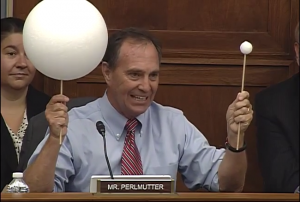
Judging by Perlmutter’s performance at the EPA/Animas spill hearing, we’re guessing the one on the right.
Congress began hearings today on the EPA river spill and first up was the Science panel on which only one member of the Colorado delegation sits – the maddeningly and embarrassingly ineffectual Democratic Rep. Ed Perlmutter.
For all the good he did, Perlmutter should have begun each sentence by stating: I refuse to ask a substantial question based on my party leader’s advice that it may damage the EPA’s alleged credibility.
Not only did he waste his allotted time asking pointless questions, but other Democrats turned over their question period to Perlmutter as well, allowing him an usually long timeframe totaling 15 minutes to find out what went wrong.
The impotence of his questioning was so astoundingly lame, we’ve decided to list them, in order, so that Coloradans can see for themselves the feeble representation we’re getting in Washington with Perlmutter. He at least admitted up front that questions about negligence or holding the EPA responsible for the spill was not on his agenda. He was more interested in making sure the Navajos in New Mexico were being treated fairly by the government. First questions went to Donald Benn, executive director of the Navajo Nation Environmental Protection Agency:
The Navajos wanted the EPA to help with some monitoring devices to keep an eye on things, to help the farmers and the ranchers who might have been impacted, am I right about that? Are those conversations ongoing with the EPA, or are you guys in litigation, where are you? So there is some conversation going on? You’re not talking to the EPA? Is the Nation speaking to the EPA about the potential ways that the EPA and the United States could help the nation?
Benn summarized just how unhappy the Navajos are, which is why they are suing the government. But, Perlmutter wasn’t interested in that, so he turned to geochemist Mark Williamson, who works for Geochemical Solutions:
Can you describe the area where this Gold King mine is and approximately how many mines are in the Silverton complex which I think ranges into the hundreds if not in the thousands?
The terrain is mountainous, Williamson responded.
To Durango Mayor Dean Brookie: And approximately when did the mining start in this area? Do you know how many mines are in that district up in the complex above Durango?
Finally, as the clock ticked out on his first round, Perlmutter asked only one question of EPA’s representative Mathy Stanislaus: If the EPA or some federal agency doesn’t help with this, who does?
Luckily for Colorado, a California Democrat turned over his time to allow Perlmutter to get at the heart of the matter, and resume questioning of the EPA thusly:
The EPA started working on this with stakeholder groups and with its professionals in 2014, did it not? So you worked with affected individuals to try to figure out what to do to minimize the 300 million gallons (from five different mines) that was being released into a river that runs right through the heart of Durango and into the Navajo nation, isn’t that right? And in so doing, you contracted with the private sector to do the construction and remediation work that the professionals felt was appropriate, did you not?
Bam! Totally nailed the EPA for, uhm, not causing a major pollution spill? Perlmutter then turned his laser-like precision questioning onto Dennis Greaney, president of the contracted company working at the mine, Environmental Restoration. Brace yourself, these are tough:
And one of those contractors was you? You’ve done some 1,300 similar kinds of tasks for the EPA and 10,000 other agencies and the private sector? The kind of work you do can be dangerous, isn’t that true? And it can be complex? How would you describe all of the tunnels that you’re dealing with in this Silverton complex when you are working on the Gold King Mine? Should the United States and should the state of Colorado, even though it may not be prudent, try to undertake to fix something like that?
Once again, Perlmutter discovered absolutely nothing. Turning back to Williamson, he quizzed: Does the EPA and Colorado division of mined land reclamation or other agencies try to undertake to mitigate against a constant release like this 300 million gallons? This is complex and dangerous work is it not?
But wait, there was a final round of questioning, in which Perlmutter asked Durango’s mayor: Good Samaritan legislation, in this instance, it wouldn’t have helped? In connection with the $8 million the EPA has spent so far, what has been done for the town of Durango, if anything?
We’ll give you the answer to this one since it’s not obvious, the mayor said zilch, cause they haven’t sent the EPA a bill for damages yet. So, Perlmutter turned his attention back to the EPA, finally:
The $8 million, what of that? Explain the mitigation that took place immediately after the release and how protecting the life and limb of your contractors and of your own personnel and what you’re done to slow down this release? For the answer to that question, we would refer you to every press release issued by the EPA since the spill.
His final question was at the heart of what every Democrat on the panel used the hearing for: There was a discussion of making these mines part of a Superfund site, how would that affect your ability to pay for new treatment plants for the area, for the Navajo Nation?
Perlmutter’s charade was a waste of time, discovered nothing, and accomplished nothing. When the hearings continue next week we’re expecting better representation, because it can’t possibly get any worse.
